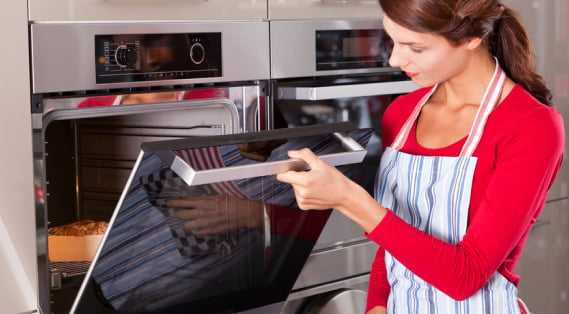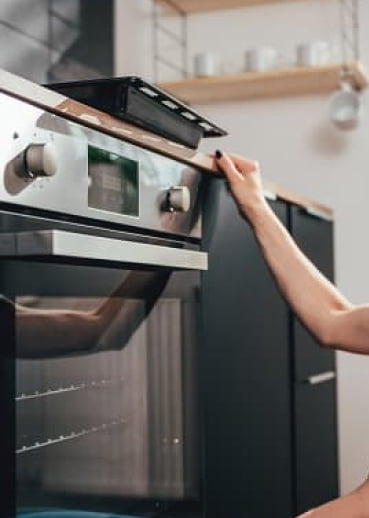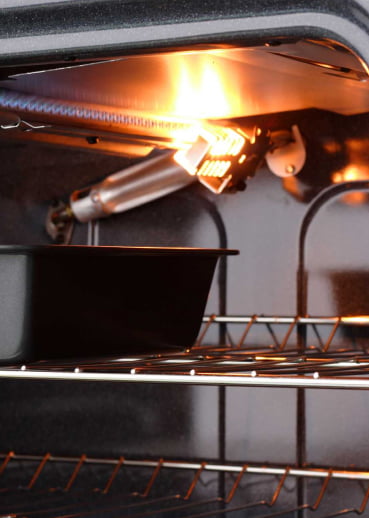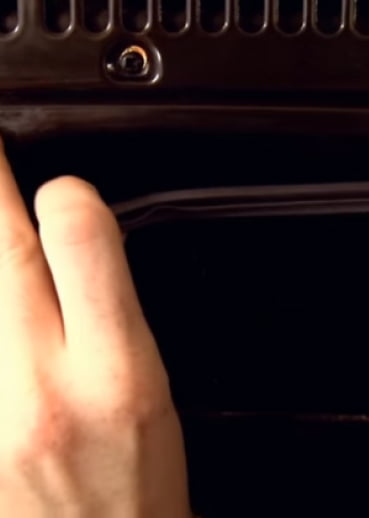Are there any questions left?
Contact us and we will answer!
COMMON OVEN PROBLEMS AND HOW TO FIX THEM: A GUIDE BY FASTAID
A malfunctioning oven can disrupt your cooking routine and leave you with unfinished meals. Whether you're an amateur chef or a seasoned cook, a properly functioning oven is essential for preparing delicious meals for your family. FastAid Appliance Repair understands the significance of a well-operating oven, and we are dedicated to providing reliable solutions for common oven problems. With our team of skilled technicians in Charlotte, NC, you can trust us to diagnose and resolve a wide range of oven issues efficiently and effectively.
In this comprehensive guide, we aim to empower homeowners in Charlotte and the surrounding areas with the knowledge and tools to troubleshoot and fix common oven problems on their own. We understand that not every issue requires professional intervention, and that's why we provide step-by-step troubleshooting and repair tips. Whether you're dealing with oven not heating, uneven cooking, faulty igniter, door seal problems, or other oven malfunctions, our guide has you covered.
By following the guidance in this guide, you can save time and money by addressing oven problems yourself whenever possible. However, if you encounter more complex or challenging issues, the FastAid Appliance Repair team is always ready to assist you. We have the expertise and experience to handle any oven repair, ensuring that your appliance operates optimally and reliably.
Common Oven Problems
Don't let common oven problems ruin your culinary creations. With FastAid Appliance Repair and this comprehensive guide, you can regain control over your oven's performance and get back to cooking with confidence. Let's dive into the world of oven troubleshooting and repairs, empowering you to become a savvy homeowner when it comes to maintaining your appliance.

Oven Not Heating
One of the most frustrating oven problems is when it fails to heat up properly. We'll explore possible causes, such as a faulty bake element, malfunctioning temperature sensor, or a broken igniter. Our guide will provide step-by-step instructions on how to troubleshoot and fix these issues, ensuring your oven heats up to the desired temperature consistently.

- Check the Power Supply: Ensure that the oven is properly plugged into a working power outlet. Test the outlet using another appliance or a voltage tester to verify its functionality.
- Inspect the Bake Element: The bake element is responsible for heating the oven. Check it for any visible damage or breaks. If you notice any issues, replace the bake element with a compatible one.
- Test the Temperature Sensor: Use an oven thermometer to compare the actual temperature inside the oven with the set temperature. If there is a significant difference, the temperature sensor may be faulty and need replacement.
- Check the Igniter: For gas ovens, a faulty igniter can prevent the oven from heating. Inspect the igniter for visible damage or wear. Replace the igniter if it is not glowing or has cracks.
- Verify the Oven Settings: Ensure that the oven settings are correct and that you are using the appropriate cooking mode and temperature.
- Calibrate the Oven: Some ovens have a calibration feature that allows you to adjust the temperature settings. Refer to the user manual for instructions on how to calibrate your oven.
Oven Uneven Cooking
If your oven is cooking food unevenly, it can lead to undercooked or overcooked dishes. We'll discuss potential causes, such as a malfunctioning convection fan, uneven heating elements, or a dirty oven interior. Our guide will offer practical solutions to address these problems and ensure even cooking results.

- Use Oven-Safe Cookware: Use oven-safe cookware with flat and even bottoms to promote even heat distribution.
- Preheat the Oven: Preheating the oven for the recommended time ensures that the entire oven cavity reaches the desired temperature.
- Rotate Food During Cooking: If you notice uneven cooking, rotate the food halfway through the cooking time to ensure even exposure to heat.
- Check the Convection Fan: If your oven has a convection feature, check the convection fan for proper functioning. A faulty fan can disrupt even airflow and cooking.
- Clean the Oven Interior: Food debris or spills on the oven's interior can cause hot spots and uneven cooking. Regularly clean the oven to maintain consistent cooking performance.
- Test Oven Thermometer: Use an oven thermometer to verify the accuracy of the oven's temperature settings. Adjust the settings or calibration if needed.

Oven Faulty Igniter
In gas ovens, a faulty igniter can prevent the oven from lighting and heating up. We'll explore how to identify a malfunctioning igniter and provide step-by-step instructions on how to replace it for optimal oven performance.
- Identify the Igniter: Locate the igniter at the back or bottom of the oven. It is usually a small rectangular or round component.
- Inspect the Igniter: Visually inspect the igniter for any visible damage, such as cracks or wear. A faulty igniter may not glow or may have a weak glow.
- Test the Igniter: Use a multimeter to test the igniter for continuity. If there is no continuity, the igniter is likely faulty and needs replacement.
- Replace the Igniter: Disconnect the oven from the power supply and remove the oven racks. Unscrew or unclip the old igniter and disconnect the wires. Install the new igniter and reconnect the wires. Secure it in place and reassemble the oven.
Oven Door Seal Problems
A damaged or worn-out door seal can lead to heat loss and inefficient cooking. We'll discuss the importance of a tight seal and explore how a faulty door gasket can lead to improper sealing and energy waste. Our guide will provide step-by-step instructions on replacing the door gasket to ensure optimal cooking conditions.

- Identify the Door Seal: The door seal, also known as the gasket, is located around the oven door frame.
- Inspect the Door Seal: Visually inspect the door seal for any visible damage, such as tears, cracks, or gaps.
- Check for Proper Alignment: Close the oven door and ensure that it aligns properly with the oven cavity. A misaligned door can cause the gasket to wear unevenly.
- Replace the Door Gasket: If the door gasket is damaged or worn out, it needs replacement. Order a compatible replacement gasket from the manufacturer or an authorized parts supplier.
- Remove the Old Gasket: Gently peel back the old gasket from the door frame. Use a screwdriver or putty knife if necessary.
- Clean the Door Frame: Thoroughly clean the door frame to remove any dirt or debris. Ensure it is dry before proceeding.
- Install the New Gasket: Starting from one corner, press the new gasket onto the door frame. Ensure it is straight and smooth.
- Test the Seal: Close the oven door and check the seal. The gasket should create a tight seal when the door is closed.
Professional Oven Repair in Charlotte, NC
While some oven issues can be resolved with DIY troubleshooting and repairs, others may require the expertise of a professional technician. FastAid Appliance Repair is your go-to partner for reliable oven repair services in Charlotte, NC, and the surrounding areas. Our team of skilled technicians has the knowledge and tools to diagnose and fix a wide range of oven problems. We understand the importance of a properly functioning oven in your kitchen, and we are committed to providing fast and efficient service to get your appliance back on track.
If you're experiencing persistent oven problems or need professional assistance with oven repairs, contact FastAid Appliance Repair today. Trust us to restore your oven's performance, so you can enjoy cooking with ease once again.
Oven Problems FAQs
Several factors can cause an oven not to heat up properly, including a faulty bake element, temperature sensor, or igniter. Start by checking the power supply, and then inspect the bake element for visible damage. Use an oven thermometer to test the temperature accuracy. If the issue persists, it's advisable to seek professional assistance.
Yes, you can replace the oven's door gasket yourself. Start by ordering a compatible replacement gasket from the manufacturer or an authorized parts supplier. Gently peel back the old gasket and clean the door frame before installing the new gasket. Ensure the gasket is aligned properly and creates a tight seal when the door is closed.
Strange noises during oven operation may indicate an issue with the convection fan, cooling fan, or heating elements. Check for loose components and clear any debris that may be causing the noise. If the problem persists, it's best to have a professional technician inspect the oven for a more accurate diagnosis and necessary repairs.
While the self-cleaning feature is convenient, it is best to use it sparingly. Frequent use of the self-cleaning cycle can put a strain on the oven's components and may lead to premature wear and tear. Follow the manufacturer's guidelines and avoid using the self-cleaning feature more than a few times a year.